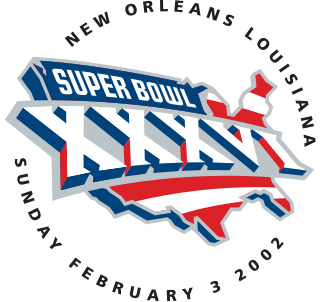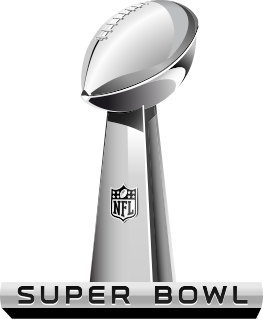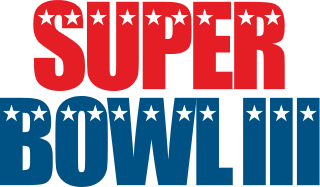
Super Bowl XVII was an American football game between the American Football Conference (AFC) champion Miami Dolphins and the National Football Conference (NFC) champion Washington Redskins to decide the National Football League (NFL) champion for the 1982 season. The Redskins defeated the Dolphins 27–17 to win their first Super Bowl championship. The game was played on January 30, 1983 at the Rose Bowl in Pasadena, California.

Super Bowl XVIII was an American football game played on January 22, 1984 at Tampa Stadium between the National Football Conference (NFC) champion and defending Super Bowl XVII champion Washington Redskins and the American Football Conference (AFC) champion Los Angeles Raiders to determine the National Football League (NFL) champion for the 1983 season. The Raiders defeated the Redskins, 38–9. The Raiders' 38 points scored and 29-point margin of victory broke Super Bowl records; it remains the most points scored by an AFC team in a Super Bowl. This was the first time the city of Tampa hosted the Super Bowl and was the AFC's last Super Bowl win until Super Bowl XXXII, won by the Denver Broncos.

Super Bowl XXXVI was an American football game between the National Football Conference (NFC) champion St. Louis Rams and the American Football Conference (AFC) champion New England Patriots to decide the National Football League (NFL) champion for the 2001 season. The Patriots defeated the Rams by the score of 20–17. It was New England's first Super Bowl championship, and the franchise's first league championship of any kind. The game was also notable for snapping the AFC East's long streak of not being able to win a Super Bowl championship, as the division's teams had lost eight Super Bowls in total. It would be the last time the Rams reached a Super Bowl during their time in St. Louis; the team would return to Super Bowl LIII in 2019 as the Los Angeles Rams 17 years later, where they would play again against the Patriots only to lose 13–3.

Super Bowl XXXIX was an American football game played between the American Football Conference (AFC) champion New England Patriots and the National Football Conference (NFC) champion Philadelphia Eagles to decide the National Football League (NFL) champion for the 2004 season. The Patriots defeated the Eagles by the score of 24–21. The game was played on February 6, 2005, at Alltel Stadium in Jacksonville, Florida, the first time the Super Bowl was played in that city.
The Statue of Liberty is a trick play in American football named after the Statue of Liberty.
The National Football League playoffs for the 1986 season began on December 28, 1986. The postseason tournament concluded with the New York Giants defeating the Denver Broncos in Super Bowl XXI, 39–20, on January 25, 1987, at the Rose Bowl in Pasadena, California.

The National Football League playoffs for the 1983 season began on December 24, 1983. The postseason tournament concluded with the Los Angeles Raiders defeating the Washington Redskins in Super Bowl XVIII, 38–9, on January 22, 1984, at Tampa Stadium in Tampa, Florida.

The National Football League playoffs for the 1982 season began on January 8, 1983. The postseason tournament concluded with the Washington Redskins defeating the Miami Dolphins in Super Bowl XVII, 27–17, on January 30, at the Rose Bowl in Pasadena, California.
In American football a play is a close to the ground "plan of action" or "strategy" used to move the ball down the field. A play begins at either the snap from the center or at kickoff. Most commonly plays occur at the snap during a down. These plays range from basic to very intricate. Football players keep a record of these plays in their playbook.
The 2001 St. Louis Rams season was the franchise's 64th season in the National Football League, the seventh season in St. Louis and the second under head coach Mike Martz. The Rams set a franchise record for wins in a season (14), while also going a perfect 8–0 on the road. Quarterback Kurt Warner would go on to win his second league MVP award. Along with Warner's 1999 MVP award and Marshall Faulk's 2000 award, the Rams had amassed the last three NFL MVP awards.

The 2001 New England Patriots season was the 32nd season for the New England Patriots in the National Football League and 42nd season overall. They finished with an 11–5 record and a division title before advancing to and winning Super Bowl XXXVI.
The National Football League playoffs for the 2008 season began on January 3, 2009. The postseason tournament concluded with the Pittsburgh Steelers defeating the Arizona Cardinals in Super Bowl XLIII, 27–23, on February 1, at Raymond James Stadium in Tampa, Florida.

The 2009 Denver Broncos season was their 40th season in the NFL and 50th season overall. The Broncos started 6–0, but lost 8 of their next 10 games after coming off bye week. They matched their 8–8 regular season record from 2008 and missed the playoffs for the fourth straight season. The Broncos welcomed many new defensive players signed during free agency, including veteran Eagles safety Brian Dawkins. This was their first season without head coach Mike Shanahan since 1995, as he was fired on December 30, 2008. On January 12, 2009, Denver hired former New England Patriots' offensive coordinator Josh McDaniels as their new head coach. At the time of his hiring, McDaniels was the youngest head coach in any of the four major North American professional sports and the fifth-youngest NFL head coach ever, though less than a week later the Tampa Bay Buccaneers named the even-younger Raheem Morris as their head coach.
The National Football League playoffs for the 2009 season began on January 9, 2010. The postseason tournament concluded with the New Orleans Saints defeating the Indianapolis Colts in Super Bowl XLIV, 31–17, on February 7, at Sun Life Stadium in Miami Gardens, Florida.
The 2014 Fiesta Bowl was a college football bowl game that was played on Wednesday, January 1, 2014, at University of Phoenix Stadium in Glendale, Arizona. In this, the 43rd annual Fiesta Bowl, the Baylor Bears, champions of the Big 12 Conference, played the UCF Knights, champions of the American Athletic Conference. The game was broadcast live on ESPN at 6:30 PM MST. It was one of the 2013–14 bowl games that concluded the 2013 FBS football season. It was sponsored by the Tostitos snack food brand and was officially known as the Tostitos Fiesta Bowl.
The 2017–18 NFL playoffs began on January 6, 2018, after the 2017 season, and concluded with Super Bowl LII on Sunday, February 4, 2018, when the Philadelphia Eagles defeated the New England Patriots at U.S. Bank Stadium in Minneapolis, Minnesota.

















